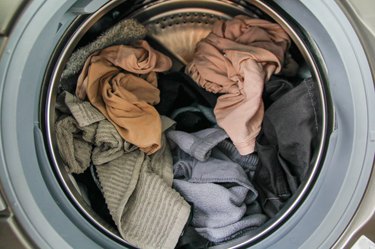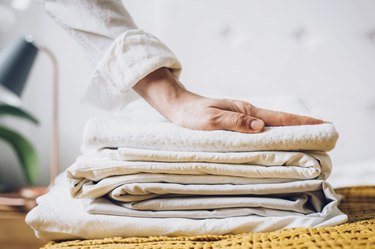When it comes to doing laundry, one of the biggest questions people have is whether or not they can dry whites and colors together. At some point in our lives, most of us have been told to separate our whites and colors when putting them in the wash, but does the same go for drying? Most of us probably haven't given it much attention.
The truth is that laundry can be a time-consuming task even if we spend less time on it now than we did before laundry machines were invented. If we can save time by throwing clothes together in the dryer, especially if we've already separated them in the wash, then why not? But could this be ruining our clothing?
Video of the Day
Video of the Day
Let's find out whether or not an attempt to save time by putting whites and colors in the dryer together may mean money wasted in the long run. We talked to a few experts to get their take on whether you should whites and colors together.
Meet the Experts
- Wendy Saladyga: Senior Manager of Research and Development, Henkel
- Jennifer Ahoni: Fabric Care Principal Scientist, Procter & Gamble
Can You Wash Whites and Colors Together?
Before we get into drying, let's back up a little. Should whites and colors be washed together, or is it still good to separate them even with all the tips and tricks out there that are supposed to stop color bleeding?
Generally, separating whites and colors when washing clothing is necessary to prevent color bleeding. Color bleeding occurs when the dye from one piece of clothing transfers onto another piece of clothing. This can happen when clothes are washed together in warm or hot water or when they're washed with bleach.
To prevent color bleeding, it's recommended to wash whites and colors separately using cold water and the appropriate laundry detergent for the type of fabric. Use chlorine bleach only with whites or color-safe bleach or detergent with colors.
All this considered, do people still wash their whites and colors together? Of course. Many of us simply don't have the time to separate colors and whites when washing them. So, here are some tips to preserve your clothes longer if you must wash them like that:
- Sort clothes according to color. While it may not be necessary to separate whites and colors completely, it's still a good idea to separate dark clothes from light clothes. This will help prevent any dark colors from potentially staining lighter clothes.
- New clothing, especially bright clothing, shouldn't be washed the first time with whites or anything it can bleed onto. So, if you have a brand-new red T-shirt and white jeans, it's best not to wash them together.
- It's also a good idea to read and follow the care label on any clothing that's delicate, valuable, or you just really love
—
or wash it by itself or with other similar garments if the care label is missing.
- Use your washer's permanent press or gentle setting
and wash your items in cold water with a laundry detergent that's formulated to work effectively in cold water washes or use a color-safe detergent or color-safe bleach that's specifically made to be safe for use on colored clothes.
- Avoid overfilling or stuffing your washer with clothes.
- Use color-catcher sheets in the wash to trap loose dye or add
1/2 cup of salt or distilled white vinegar to help prevent dyes from bleeding.
- Hand washing is another option for items that are particularly delicate or prone to bleeding. Hand washing can take a while, but it's a great way to ensure that clothes maintain their color and shape.
Can You Dry Whites and Colors Together?

If you're someone who doesn't mind keeping whites and colors together in the wash, then perhaps you haven't thought about the potential consequences of drying them together. But if you're curious about changing your laundry habits to keep your clothes lasting longer or you're already separating colors and whites in the wash and want to know if you can dry whites and colors together, the answer is: It depends on a few different factors.
We asked Wendy Saladyga, stain expert and Senior Manager of Research and Development at Henkel, to weigh in on the topic.
She said, "Can you? For the most part, you CAN — but do you want to? I'd say for the best result, the answer is often no. I would always advise the consumer to first make sure they are following the laundering care instructions labeled on the garment."
Saladyga adds, "If you have a bunch of polyester athletic shirts, sure, go ahead and throw them in together. But when you start mixing different colors and fabric types, your potential for an unwanted result goes up. For example, if you dry dark jeans and a white shirt, you have a good chance of transferring color to the white shirt from them rubbing together. It is called 'crocking' — and not a result that you want to see on your bright white shirt."
"Additionally, there is something called 'pill transfer.' It's a strange term, but we have all experienced it at one point or another if we mix our loads. Those little pills on a shirt that are a totally different color than the shirt itself. Mixing colors makes this possible. So, if you don't want to risk it, don't mix your colors."
These are just a few things that can happen when you dry whites and colors together. But let's dig into this a bit more so you can make the best decisions about your clothing going forward.
Understand the Impact of High Temperatures on Fabric
If you dry whites and colors together, your dryer load might be larger than if you were doing them separately, which may mean you have to crank up the dial to ensure everything gets dried properly, right?
But high temperatures can impact the fibers in the clothing, leading to shrinkage, dye transfer, abrasions, and excessive lint, thus shortening the life of your clothes, including causing any elastic to deteriorate.
That said, different types of fabric have different tolerance levels to heat. For example, cotton and linen are more likely to shrink when exposed to high temperatures, while polyester and nylon are less likely to shrink but can have the fibers damaged. It's also important to note that some fabrics, like wool and silk, should never be dried in a machine because the fibers will be easily damaged.
To help mitigate this, here are a few tips for drying whites and colors:
- Use the appropriate dryer setting. If your clothes are made of delicate fabrics or are prone to bleeding, use the lowest heat setting possible.
- Always check the care label on your clothes before placing them in the dryer to ensure you're using the right setting.
- Consider the type of fabric you're working with. Some fabrics, like cotton, are much more likely to bleed or fade when exposed to high temperatures.
- Look at the colorfastness of the clothes. If the clothes are new or have never been washed before, they're more likely to bleed. On the other hand, clothes that have been washed multiple times are less likely to bleed.
Knowing the impact that the high temperatures of a dryer can have on fabric in general means that it's important to consider this above drying whites and colors together. Even if you dry them separately, if the temperatures are too high, you could still damage your clothes.
Choose the Correct Dryer Machine and Settings
Additionally, choosing the right dryer as well as the appropriate settings on that dryer can make a big difference in how long your clothes will last and may also determine how safe it is to dry whites and colors together.
Drying Machines
The dryer itself can have an impact on how well your clothes can withstand drying, especially if you don't plan on separating your whites and colors.
- If possible, avoid using older dryers that may not have precise temperature control or moisture-sensing capabilities, as these can damage your clothes and cause shrinkage and color bleeding.
- A front-load dryer with a window in the door can help you keep an eye on your clothing while it's in the dryer.
- Make sure your machine is hooked up properly and don't be afraid to call in a professional if you need some help with installation or repairs. Broken dryers can also damage clothing.
Dryer Settings
When it comes to dryer settings, it's important to choose the right temperature and cycle time. This is because choosing the wrong setting for the wrong fabric can damage your clothes, leading to a big disappointment when you start folding your clothes and wonder if that shirt is actually yours.
To combat this, most dryers today have settings/suggestions based on the fabric that account for the temperature and time together, so use that as a guideline. Some examples of this include:
- Gas vs. electric machines can make a difference in the settings. For instance, gas machines can heat up faster than electric machines.
- Jeans, towels, and other heavy cotton items should go on high heat.
- T-shirts and other basic everyday items should go on medium heat.
- Stretchy items, like spandex, should go on low heat.
- Use the air-dry or air-only setting for undergarments and delicates, which means no heat is added. Cotton underwear and briefs should be OK on a permanent press setting, as high heat will dry them but may ruin the waistband and thus their longevity.
If you do wash whites and colors together, some dryers have a "mix" setting that may help prevent issues like color bleeding, crocking, and pilling, as Saladyga mentioned. However, remember that nothing is guaranteed; to be extra safe, it doesn't hurt to separate them.
Other Tips for Safely Drying Whites and Colors Together
Keeping fabrics, the type of dryer machine, and the settings on the dryer in mind, there are other ways to not only safely dry your clothes in general but to dry whites and colors together safely too. By following these tips, you can help protect your clothes while also saving time by choosing to dry both together:
- Before you put your clothes in the dryer, make sure to remove any lint that may have accumulated on them during the wash cycle. Most dryers have a small part where a tray fits in. That tray collects the lint. Pull it out, take out the lint, and place the tray back in the dryer.
- Be careful with dark colors. Dark colors are more likely to bleed, so it's best to wash them separately before they hit the dryer.
- It's a good idea to clean your lint filter before or after each dryer cycle. More lint is an indication that the fabrics are coming off the clothes in the dryer. Also, if you have pet hair you're concerned about, a pet hair catcher can help ensure your clothes will be ready to wear (without needing a lint brush) when you remove them from the dryer.
- When in doubt, check the care label on the clothes.
- When in a lot of doubt, head to the laundromat or cleaners. They can help to safely dry your clothing.
- Keep your eye out for sunny days, which are often better for drying clothes than using your dryer. And you can hang whites and colors together on the same rack with no problem!
Should I Dry My Whites and Colors At the Same Time?
We asked another expert, Jennifer Ahoni, Fabric Care Principal Scientist at Procter & Gamble, to weigh in as well.
"Separating your laundry by color, fabric type, and soil level prolongs the life of your laundry. It is important to sort laundry by color, specifically, because dyes are not stable and can transfer onto other clothes (especially lighter-colored ones) in the wash. Furthermore, it's important to maintain this separation when you put clothes into the dryer as well because when clothes are still wet, there is a chance [that] some dyes can bleed onto other clothing."
She adds, "For the best results, sort your laundry into whites/lights, brights, and dark colors for both the wash and dryer. Wash deep-colored clothing, like indigo jeans or red sweatshirts, by themselves for the first few washings and also make sure to dry these items separately."
Ultimately, it's possible to dry whites and colors together in the laundry if you must, but it's important to understand what the consequences could be based on expert advice. Be mindful of what the label says, the type of fabric, and whether or not your dryer is up for the challenge. Some clothing may be better equipped for being thrown in together, but it may be risky with other garments.
Therefore, if you have time on your hands, it may be worth it to split up your clothes in the dryer — and not just according to whites and darks but other factors as well.


